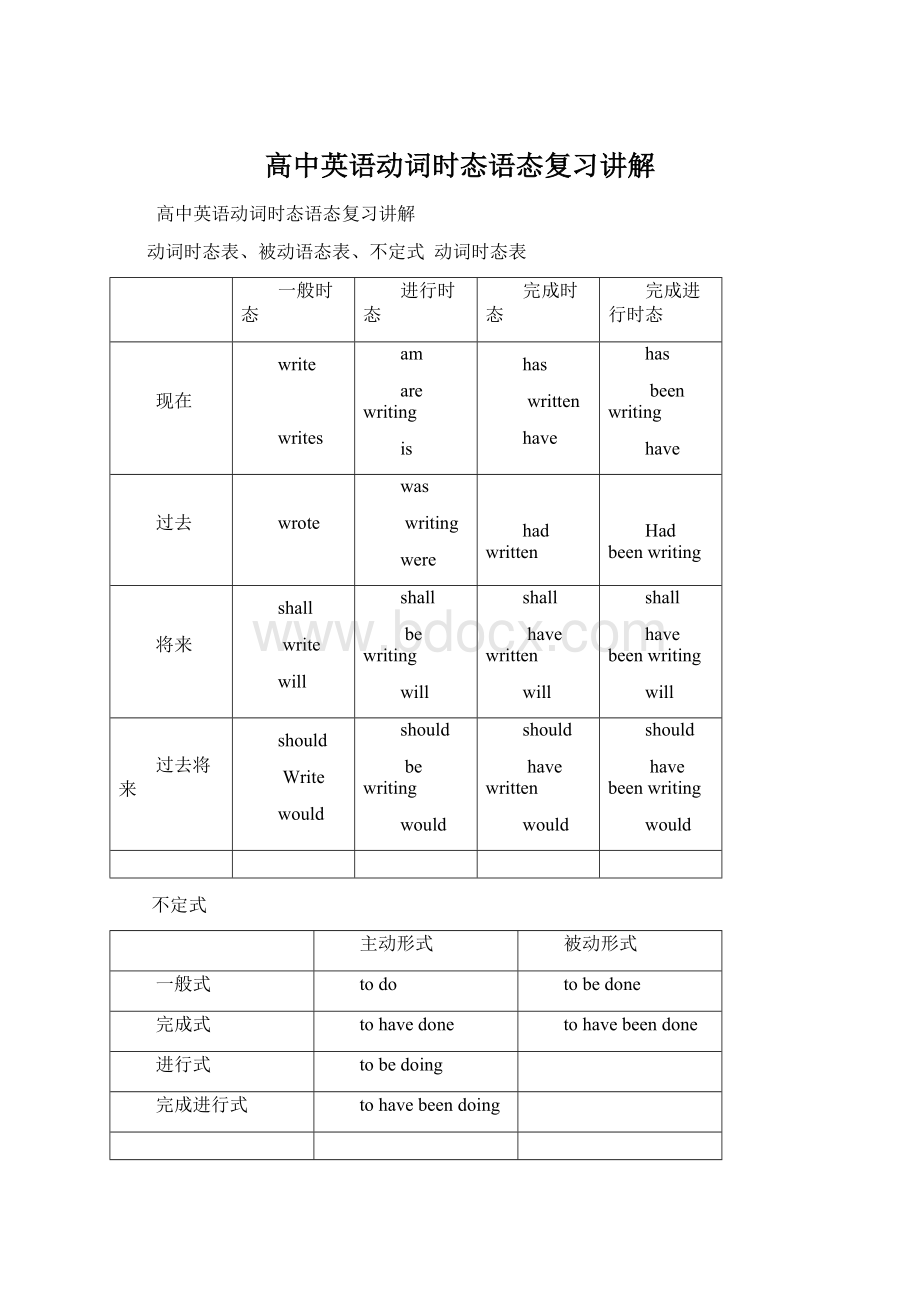高中英语动词时态语态复习讲解.docx
《高中英语动词时态语态复习讲解.docx》由会员分享,可在线阅读,更多相关《高中英语动词时态语态复习讲解.docx(14页珍藏版)》请在冰豆网上搜索。

高中英语动词时态语态复习讲解
高中英语动词时态语态复习讲解
动词时态表、被动语态表、不定式动词时态表
一般时态
进行时态
完成时态
完成进行时态
现在
write
writes
am
arewriting
is
has
written
have
has
beenwriting
have
过去
wrote
was
writing
were
hadwritten
Hadbeenwriting
将来
shall
write
will
shall
bewriting
will
shall
havewritten
will
shall
havebeenwriting
will
过去将来
should
Write
would
should
bewriting
would
should
havewritten
would
should
havebeenwriting
would
不定式
主动形式
被动形式
一般式
todo
tobedone
完成式
tohavedone
tohavebeendone
进行式
tobedoing
完成进行式
tohavebeendoing
被动语态表
一般时态
进行时态
完成时态
现在
am
isgiven
are
am
isbeinggiven
are
has
beengiven
have
过去
was
given
were
was
beinggiven
were
hadbeengiven
将来
shall
begiven
will
shall
havebeengiven
will
过去将来
should
begiven
would
should
havebeengiven
would
动词的时态语态
1.时态
时态
用法
例示
一般现在时
现在习惯或经常反复发生的动作或存在的状态,常与usually,always,seldom,often,frequently,everyday等时间状语连用
Wealwayscareforeachotherandhelpeachother.
Hesometimesstayuptillmidnighttocatchupwithothers.
主语现在的特征,性格和状态
Sheisalwaysreadytohelpothers.
-doyousing?
–alittle
客观规律,正确事实或科学真理,格言以及其他不受时间限制的客观存在
Allthelivingthingsontheearthdependonthesun.
Ourteachertoldustheearthgoesroundthesun.
在由连词if,unless,before,assoonas,when,once,however等引起的时间(条件,让步)状语从句,需用一般现在时表将来。
Evenifitrainstomorrow,thesportsmeetwilltakeplace.
Howevermuchadviceyougivehim,hewilldoexactlywhathewants.
安排,或计划要做的动作(有时间状语)限于begin,come,leave,go,arrive,open,start,stop,close,return等一类动词。
Theplanetakesoffat5:
00a.m.
一般过去时
表示过去发生的动作或存在的状态,常与yesterday,in1996,twoyearsago,lastmonth,thedaybeforeyesterday,theotherday等表示过去的时间状语连用。
TheGreatWallcameintobeingin221BC.
过去一段时间内经常或反复发生的行为,常与everyday,often,sometimes等时间状语连用,usedto,would常用来表示过去经常或反复发生的行为。
Would不接表示认识或状态的词,但usedto不受限制。
WhenIwasinthefactory,Ioftenworkedintheworkshop.
Weusedtogetupatfiveeverymorningwhenwereatschool.
WewouldaskhimforadvicewhenwehadtroublewithourEnglish.
HeusedtolikefootballwhenIwasatmiddleschool.
过去发生的一系列动作
Theprofessorputonefingerinhismouth,tastedit,andsmiledwithsatisfaction.
在时间,条件,方式让步状语从句中用一般过去时表过去将来时。
Hesaidhewouldletusknowifhegotanynews.
Hepromisedthathewouldbuysomecopiesforuswhenhewentthere.
Ididn’tknowyouboughtthepresentforme.
语境中的过去时,往往表示“刚刚,刚才,”之意,暗示现在已“不再这样”
一般将来时
Shall/will+动词原形1单纯表将来2不用于条件句中3表必然的将来4表意愿,决心
Hewillbethirtyyearsoldnextyear.
Ifyouwillwaithere,themanagewillbeback10minslater.
Begoingto1计划打算干2,客观迹象预示
Lookattheclouds,thereisgoingtobeastorm.
Ifyouaregoingtodoit,youhadbetterdoitwell.
Beonthepointof/beaboutto不与时间状语连用,但可和when从句连用
Beto1预定要做2表示命令,禁止应该3注定
Wearetofinishtheworkbeforefivethisyear.
Nooneistoleavethecinemawithoutthepolice’spolice’spermission
瞬间动词的现在进行时表将来。
Gostart,setout,leave,reach,arrive,return,come,move,takeoff
TheyaremovingNanjingforGuangzhouonSunday.
祈使句/短语+and/or+主语+will
Workhardandyou’llsucceed
Abitmoreeffort,andyouwillsucceed.
将来完成时
表示在将来的一个特定时刻将成为过去的动作或该时刻刚刚结束的动作
Ishallhavefinishedthisonebeforelunch.
Ihopewe'llhavegottheinstructions(说明书)readybeforeyoucometomorrow.
过去将来时
Was/weregoingto
Was/wereto
Wasaboutto
Was/were+现在分词
Was/wereonthepointof
现在进行时
表示现在(说话瞬间)正在进行或发生的动作
Look!
Theboyisdozingoff.
表示当前一段时间内的活动或现阶段正在进行的动作。
(说话时动作不一定正在进行)
HowareyougettingalongwithyourEnglishthesedays.
表示说话人对主语的行为表赞叹或厌恶。
(常与always,constantly,continually等副词连用)
Thechildrenarealwaysmakingtrouble.
Sheisalwaysaskingthesamequestion.
瞬间动词表将来
过去进行时
表示过去某一时刻或某一段时间正在进行的动作。
这一特定的过去时间,除有上下文暗示外,一般和时间状语连用。
表示说话人对主语的行为表赞叹或厌恶。
(常与always,constantly,continually等副词连用)
瞬间动词表将来
描写故事的背景
Itwaswinter.Thenorthwindhasblowinghardandaheavysnowwasfalling.Apoorlittlegirlwaswalkinginthestreet.
用在复合句中
Hewasreadingwhilehiswifewascooking.
Whilehewasdriving,hewasthinkingaboutthematter.
不与时间状语连用,表示逐渐的发展
Itwasgettingdarker.
现在完成时
对现在的影响或动作与状态的持续
常与有介词for,during,inwithin,over引导的时间状语连用
Wehavediscussedthetopic(for)thelast3weeks.
Ihaven’tseenhimintherecentyears.
表示反复或习惯性的动作,常与
severaltimes,once,twice,等频度副词
连用
Ihavewatchedhimseveraltimes.
HehasbeentoLondontwice.
用在时间,条件状语从句中,表示从句动作先于主句动作之前已完成。
IwillgivemyopinionafterIhavereadthroughthebook.
Wewillsetoutatonceiftherainhasstopped
现在完成进行时
表示从过去某一时刻开始的动作一直延续到现在,甚至将来。
(强调进行的过程)
Heisill.hehasbeenlyinginbedforthreeweeks.
Sheisverytired.shehasbeentypinglettersallday.
一直到现在为止的一段时间内一再反复进行的动作
Alltheseyearstheyhavebeencontributingarticlestoourmagazine.
过去完成时
表示过去的过去;一直延续到过去某一点的动作或状态。
Ireceivedaletterfromafriendyesterday.Wehadnotheardfromeachothersince1990
表示原本打算实现而未实现的希望或计划。
常用此结构德动词有hope,want,expect,think,mean,suppose,intend等
Wehadhopedtocatchthe9:
30train,butwefailedto.
Theyhadexpectedtogetwhattheyneeded,buttherewasnothingthere.
用于nosooner…than;hardly…when的句型中
Ihadnosoonerreturnedthanhecalled.
时态比较
过去进行时表示在过去某一时刻正在进行的动作。
一般过去时表示动作的完成
Marywrotealettertoherfriendlastnight.
Marywaswritingalettertoherfriendlastnight.
现在完成时强调结果或动作已完成
现在完成进行时强调动作在继续
Wehavediscussedthequestionwithhim.
Wehavebeendiscussingthequestionwithhimallevening.
固定句型
Bytheendof
Bytheendoflastterm,wehadlearned2000words.
Bytheendofthisterm,wewillhavelearned…
Itisthefirsttime
Itwasthefirsttime
Itishightimethat
Itisthefirsttimethatyouhavevisitedourschool.
Itwasthefirsttimethatyouhadvisited…
Itishightimethatyoucamehere.
2.语态
主动表被动
及物动词作不及物用+副词(hardly,easily,badly,nicely,well,smoothly)等时。
常用动词有act,add,bend,close,lock,cut,begin,move,open,read,sell,teach,translate,wash,wear,write等,主语往往是物而不是人。
Thepenwritewell.
Woodburnseasily.
Thecardrivessmoothly.
Thecaselockseasily.
形容词+不定式结构中,不定式与句子主语有动宾关系时。
要注意如果句中的主语是不定式的逻辑主语时用主动语态,否则用被动。
Thepictureispleasanttolookat.
Ifoundhistheoryhardtounderstand.
Ifoundmytheoryhardtobeunderstood.
介词短语insight,onshow,onsale,underconstruction作表语或定语表被动。
Thenewrailwayunderconstructionwillbecompletedsoon.
Beworth,bemissing,inneedof,remaining,want/need/requirebetoblamebetolet
Theteachingmethodisinneedofimproving.
Thereisnoremainingmoneyhere.
Thehouseistolet
连系动词:
表感觉的appear,feel,prove,taste,表变化的become,comefall,grow,turn,表依旧的continue,lie,remain,stay,stand
Einstein’stheoryprovedtobecorrect.
某些动词以物做主语,进行时表被动eg.Print,cook,fry,hang,build,make
Thedinneriscooking.
Thebookisprinting.
Thehouseisbuilding.
被动表主动
Burn,devote,dress,hide,seat,love,wear,tire+oneself+介词=be+ed+介词
Heseatshimselfonthebench.
Affect,amuse,astonish,delight,disappoint,discourage,encourage,excite,frighten,inspire,move,strike,touch,upset,worry等用于sb+be+edsth+be+ing作定语ed+sbing+sth
Hewastoofrightenedtomove.
不用被动语态
Comeabout,occur,breakout,belongto,happen,succeed,fail,addupto,takeplace,comeintobeing,cost,setsailfor,takepartin,giveout,cometrue,loseheart,playapartin
双重被动式
常用的动词有wish,expect,advise,mean,believe,suppose,order,allow
ThebookisbelievedtohavebeentranslatedintoFrench.
Thesportsmeetwasneverexpectedtobeputoff.
Get,become,go,come,feel,grow,seem,look可以作为系动词在口语中使用
Igrewexcitedandalittlefrightened.
Heseemedsatisfiedwithmyoffer
Fivesoldiersgotwoundedinthebattle.
高考对于进行体的常考点
1.一个长动作作为背景,被一个短动作打断,长动作往往用进行体,短动作用一般体。
Tomslippedintothehousewhennoonewaslooking.
Ashewasreadingthenewspaper,grannyfellasleep.
2.表示动作的未完性,暂时性。
Idon’treallyworkhere.Iamjusthelpingoutuntilthenewsecretaryarrives.
Selectingamobilephoneforapersonaluseisnoeasytaskbecausetechnologyischangingsorapidly.
3.表示现在或当时发展中或正在进行的情况。
Idon’tthinkJimsawme;hewasjuststaringintospace.
IfirstmetLisa3yearsago.Shewasworkingataradioshopatthattime.
动词时态、语态汉语的时态大多是通过副词来表达的,而英语的时态是靠动词的变化和时间状语来表达的。
英语中的时态共有十六种,但是常考的或较常用的只有9种,而且重点测试完成时态。
要掌握英语的时态和语态,必须掌握好英语中的助动词(do,be,have)和时间状语这两个核心问题。
1、一般现在时主要用来表示人、事物的现在状况和特点;表示经常或习惯性的动作,句子中常有often,always,fromtimetotime等时间状语;表示客观规律和永恒真理等。
Heusuallygoestoworkat7o’clockeverymorning.
ShehasabrotherwholivesinNewYork.Theearthgoesaroundthesun.
GuangzhouissituatedinthesouthofChina.
考点一:
表示永恒的真理,即使出现在过去的语境中,仍用一般现在时。
如:
IlearnedthattheearthgoesaroundthesunwhenIwasinprimaryschool.
考点二:
在时间和条件状语从句中,代替一般将来时;常用的引导词有:
时间:
when,until,after,before,assoonas,once,themoment/theminute,theday;条件:
if,unless,provided.
Ifheacceptsthejob,hewillgetmoremoneysoon.
考点三:
在makesure(certain),seetoit,mind,care,matter+宾语从句,从句用一般现在时代替一般将来时。
Solongasheworkshard,Idon’tmindwhenhefinishestheexperiment.
只要他努力工作,我不介意他什么时候做完试验。
考点四:
在themore…themore…(越……越……)句型中,若主句是一般将来时,从句通常用一般现在时。
Theharderyoustudy,thebetterresultsyouwillget.
2、现在进行时
表说话时或目前一段时间内正在进行的活动:
或表感情色彩,加强语气。
与频率副词,如always,constantly,continually,again等连用表示说话人的某种感情色彩(赞叹、厌烦、埋怨等)。
WearehavingEnglishclass.Thehouseisbeingbuiltthesedays.
Thelittleboyisalwaysmakingtrouble.
考点一:
在时间状语或条件状语从句中表示将来正在进行的动作。
Lookoutwhenyouarecrossingthestreet.
Don'twakehimupifheisstillsleepingat7tomorrowmorning.
考点二:
表示在最近按计划或安排要进行的动作(这时多有表示将来的时间状语)。
MarryisleavingonFriday.
3、现在完成时
表示动作发生在过去,完成在过去